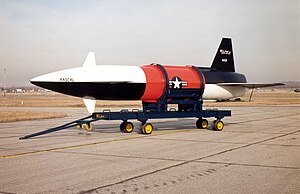| GAM-63 RASCAL | |
|---|---|
 | |
| Type | Air-to-surface missile |
| Service history | |
| In service | 30 October 1957 (planned) |
| Production history | |
| Manufacturer | Bell Aircraft |
| Unit cost | $2,262,000 |
| Produced | 1952 |
| Specifications | |
| Mass | 18,200 lb (8,255 kg) |
| Length | 31 ft 11.5 in (9.74 m) |
| Diameter | 4 ft (1.22 m) |
| Wingspan | 16 ft 8.3 in (5.09 m) |
| Warhead | W-27 nuclear |
Detonation mechanism | Airburst or surface |
| Propellant | Bell XLR-67-BA-1 liquid propellant rocket engine with 10,440 lbf (46.4kN) of thrust |
Operational range | 100 miles (161 km) |
| Flight ceiling | 65,000 ft (19,812 m) |
| Maximum speed | 1,950 mph (3,138 km/h) |
Guidance system | GAM-63 - command guidance with radar imaging GAM-63A - inertial guidance/command with radar imaging |
Launch platform | B-36, B-50, and B-47 |
The GAM-63 RASCAL was a supersonic air-to-surface missile that was developed by the Bell Aircraft Company. The RASCAL was the United States Air Force's first nuclear armed standoff missile. The RASCAL was initially designated the ASM-A-2, then re-designated the B-63 in 1951 and finally re-designated the GAM-63 in 1955. The name RASCAL was the acronym for RAdar SCAnning Link, the missile's guidance system.[1] The RASCAL project was cancelled in September 1958.
- ^ Jenkins, Dennis R. (1 July 2006). Little RASCAL: the first stand-off weapon. Airpower, p. 44